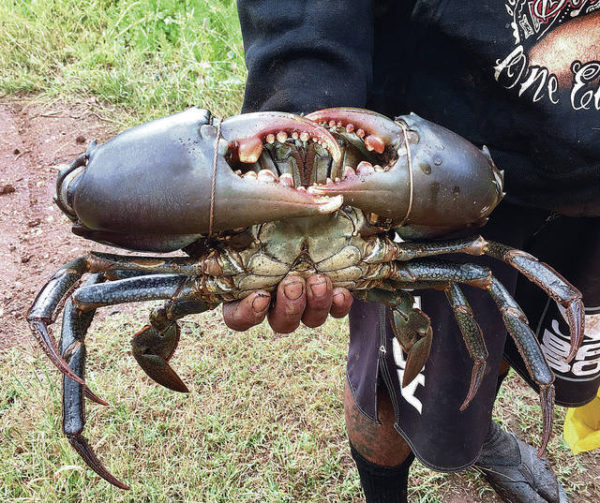Published in the Ocean Watch column, Honolulu Star-Advertiser © Susan Scott
April 7, 2018
‘We were on a bike ride around West Loch (Pearl Harbor National Wildlife Refuge) to the Bird Sanctuary,” Gary and Heide (no last name) emailed last week. But although the scenery and birds there were a joy to see, it wasn’t a bird that made their outing memorable. It was a saw-toothed sea monster.
A man had caught the granddad of Samoan crabs, Scylla serrata.
 A large male Samoan crab caught at West Loch.
A large male Samoan crab caught at West Loch.
Courtesy readers Gary & Heide.
Gary and Heide’s photo accompanying this column showed that whoever assigned the scientific name to the creature got it right. The first word, Scylla, was a sea monster in Greek mythology that lived on one side of a channel, and if you sailed too close, the six heads would eat the crew. In reality, Scylla is associated with sharp, shallow rocks in a passage between Italy and Sicily.
The species name seratta means a saw-toothed edge, referring to the crab’s prominent spines, four between the eyes and nine on each side, that run along the front of the upper shell. Mature males grow to a shell width of 9 inches, weigh up to 5 pounds and have front claws that put sea monsters to shame.
Only in Hawaii is this crab known as a Samoan crab, so called because the crabs came from Samoa. Between 1926 and 1935 people hoping for an additional food source in Hawaii brought 98 individuals from Samoa to Oahu and Molokai. The crabs, which like most crabs eats anything dead or alive, flourished here, and are now found on all the main islands.
Mud crabs are native to the warm waters of the Indian and Pacific oceans, but because they grow large and are good to eat, people also have introduced the crabs to Florida and the Gulf of Mexico. Because the species prefers sheltered estuaries with muddy bottoms, people in other parts of the world call the creatures mud crabs or mangrove crabs.
Samoan crabs are so popular here that the state protects the population by law. All females of all sizes must be released if caught. The minimum shell width for males is 6 inches.
Samoan crabs reproduce during the warmer months. When a female is close to molting, she sends out a chemical attractant. The male climbs on top of the female, holds her with his hind legs and carries her around until she molts, up to four days. The male then turns her over and deposits his sperm capsule.
The female stores this little gift. When her eggs are ready, the mother-to-be migrates offshore, puts her warehoused sperm to good use and releases 2 million to 5 million fertile eggs. It’s up to the larvae to find their way back to shore.
Gary and Heidi sent nice pictures of the West Loch wetland and two Hawaiian stilts enjoying it. But it was the huge crab that popped my eyes out. When I asked if I could share the photo here, they emailed back, “Sure! iPhones are GREAT.” I agree.